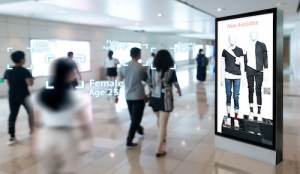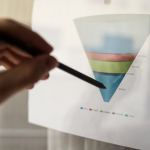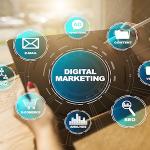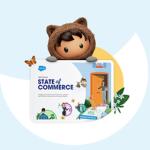The world of the marketer has never moved faster. With an exponentially growing amount of digital channels, automation, and AI rapidly changing the face of marketing, where will we be in 10 years’ time? In this blog, I look at today’s marketing automation trends and explore what the future might look like.
As a father of two, I often think about how I can best prepare my kids for their adult lives. In a not-so-distant future, just over the horizon, where all our parcels are delivered by drones, robots clean the house, and we travel in autonomous vehicles. We’ll learn and work from home, meet friends in virtual and augmented reality, 3D-print our own Christmas gifts, and everything will be voice-controlled and connected.
So, what skills will my children need to have for careers like my own in this impending future?
Welcome to the age of intelligent marketing
As the fourth industrial revolution blurs the lines between the physical, digital, and biological worlds, almost every sector is impacted by disruptive technologies, including automated marketing. From AI and robotics to the Internet of Things (IoT) and 3D printing, the technologies of the future are already making a huge difference today.
For example, AI tells marketers the following:
- prospects to prioritise based on fit and intent
- marketing assets to use to increase performance and engagement
- campaigns to repeat for what purposes
It even tells us what we can expect in ROI, including the probability of achieving a sale. With these capabilities already being delivered without human intervention, what’s next? If my kids want to work in marketing, what will their jobs entail?
To start with, I suspect the distinction between B2B and B2C marketing will disappear completely as marketing tactics are similar while B2E (Business to Experience) is becoming the norm.
Supported by AI, automated marketing will be more productive, and about making choices based on computer-generated predictions in order to personalise engagements at scale and across many new emerging channels.
We’re now used to conducting virtual meetings from the comfort of our own homes. But imagine these meetings supplemented with augmented reality (AR) showing the latest visual analytics and insights on-screen. You can get real-time data confirming your customer’s preferred devices, the best time to contact them, and the most suitable creative content for that individual.
Based on your marketing objectives, you’re presented with a list of recommended next-best actions, and while you make decisions on what to do next, voice transcripts or 3D virtual drawings are translated into marketing automation logic to test before you activate your next campaign. A simple voice command confirms your choice of action, and the rest of the campaign is completely automated.
Data, data, everywhere
So, where does the data for these predictive analytics come from? Digital platforms, of course. There’s no doubt that COVID-19 has accelerated the trend towards digitalisation.
According to McKinsey, the pandemic has led to an increase in digital initiatives by an average of 11-23% From self-service portals and chatbots to conversational marketing, apps, and more connected devices, the marketing toolset is rapidly evolving as these projects come to fruition.
In fact, as of April 2020, the MarTech landscape already featured more than 8,000 tools serving many different marketing needs and channels. As well as the obvious marketing tools, we all use connected devices that generate data on a daily basis — from vacuum cleaners and cameras to digital personal assistants and smart home products. All these digital platforms are not only designed to serve customers more effectively but also capture massive amounts of data.
But how do we make sense of it all?
This will be the key focus underpinning a large part of marketing-based roles in the future. It will be down to the marketers to learn how to collate, correlate, and visualise this data in meaningful ways, so we can turn it into actionable insights and smart decisions. See marketing automation in action.
In addition to these roles in data analytics and automation, creative teams will also remain important. After all, there’s some content that will still require the human touch. But rather than working in siloed environments as teams often do now, creating content will have to become a more embedded function in the marketing automation and decision-making process.
A digital journey centred around the customer
The overarching goal of all these analytics is to help the marketer deliver a seamless customer experience — from the initial contact through to onboarding, renewals, and even referrals. This is no longer dependent upon a single touchpoint, but rather multiple daily interactions across diverse, and increasingly digital, channels and devices.
According to Gartner, 80% of B2B sales interactions between suppliers and buyers will occur in digital channels by 2025.
Every engagement and every channel requires a unique approach to be relevant. So one of the key challenges the new generation of marketers will face is how to optimise creativity and automation while ensuring the customer experience is flawless. This goes beyond prospect marketing.
The connected after-sales experience across the lifecycle of a product will become so much more important to build customer intimacy as the sales process becomes increasingly automated. Building a 360-degree understanding of your customer and loyalty management are both critical concepts in this process.
It’s not only marketers that will be affected as virtual work environments become the default — the job of the sales rep is also changing rapidly. Sales will have to start applying more digital strategies in order to engage with customers online and become more skilled in online engagement tools while working more closely with their marketing colleagues. Breaking down silos and account-based engagement are becoming critical to success.
Preparing for the future
So, how can I prepare my kids for this creative, digital, automated, and data-driven world of work? Well, if marketing is their passion, I will help them build their skills in data and analytics or focus on the creative side if it suits them better. But what kind of workforce will be needed in five, 10, or 20 years’ time? What skills should your kids be learning?
These are the questions I’m asking, and businesses should be thinking along the same lines. What are the disruptive trends in your industry? What microeconomic impact will they have? How will more advanced robotics and AI impact your business and supply chain?
With the current rate of change, the main lesson I’m going to be teaching my kids is the importance of being flexible and ready to constantly re-educate themselves. And the same applies to any business that wants to continue to succeed in the digital age.
Discover how Salesforce can help you prepare for the future with these resources:
- Trailhead: our free online learning platform for anyone to learn all about digital 360, customer 360, loyalty cloud, marketing automation, analytics, and much more.
- How to Turn Your Virtual Sales Team into Superstars with Marketing Insights & AI.
- ABM Inspiration: 3 New Resources to Help You Fine-tune Your Strategy.
- Read our recent announcement on Salesforce Digital 360!
- Watch a one-minute demo to learn how B2B marketing automation by Salesforce can help you increase leads, boost sales, and more.

























